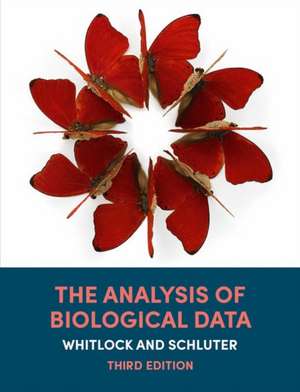The Analysis of Biological Data (International Edition)
Autor Michael C. Whitlock, Dolph Schluteren Limba Engleză Hardback – 2 mar 2020
For the first time, this textbook comes with SaplingPlus, the best online resource to teach students the problem-solving skills they need to succeed in Statistics. SaplingPlus combines Sapling¿s acclaimed automatically-graded online homework with an extensive suite of engaging multimedia learning resources.
To learn more about SaplingPlus and how to purchase access, visit www.macmillanihe/sapling
Preț: 431.14 lei
Preț vechi: 616.83 lei
-30% Nou
82.50€ • 85.97$ • 68.31£
Carte disponibilă
Livrare economică 13-27 martie
Livrare express 27 februarie-05 martie pentru 226.25 lei
Specificații
ISBN-10: 1319325343
Pagini: 848
Ilustrații: Bibliographie
Dimensiuni: 239 x 193 x 37 mm
Greutate: 1.35 kg
Ediția:3rd ed. 2020
Editura: Macmillan Learning
Colecția W. H. Freeman
Notă biografică
Michael C. Whitlock; Dolph Schluter
Cuprins
PART 1 INTRODUCTION TO STATISTICS
1. Statistics and samples 1
INTERLEAF 1 Biology and the history of statistics 23
2. Displaying data 25
3. Describing data 65
4. Estimating with uncertainty 95
INTERLEAF 2 Pseudoreplication 115
5. Probability 117
6. Hypothesis testing 149
INTERLEAF 3 Why statistical significance is not the same
as biological importance 176
PART 2 PROPORTIONS AND FREQUENCIES
7. Analyzing proportions 179
INTERLEAF 4 Correlation does not require causation 201
8. Fitting probability models to frequency data 203
INTERLEAF 5 Making a plan 233
9. Contingency analysis: associations between
categorical variables 235
Review Problems 1 269
vii
WS2_Frontmatter_pi-xxxiv_v2.indd 7 13/07/16 11:55 AM
viii Contents in brief
PART 3 COMPARING NUMERICAL VALUES 10. The normal distribution 273
INTERLEAF 6 Controls in medical studies 301
11. Inference for a normal population 303
12. Comparing two means 327
INTERLEAF 7 Which test should I use? 366
13. Handling violations of assumptions 369
Review Problems 2 417 14. Designing experiments 423
INTERLEAF 8 Data dredging 456
15. Comparing means of more than two groups 459
INTERLEAF 9 Experimental and statistical mistakes 500
PART 4 REGRESSION AND CORRELATION
16. Correlation between numerical variables 503
INTERLEAF 10 Publication bias 535 17. Regression 539
INTERLEAF 11 Using species as data points 593
Review Problems 3 597
PART 5 MODERN STATISTICAL METHODS
18. Multiple explanatory variables 605
19. Computer-intensive methods 635
20. Likelihood 655
21. Meta-analysis: combining information from
multiple studies 681
Descriere
The evolution of a classic
The new 12th edition of Introduction to Genetic Analysis takes this cornerstone textbook to the next level. The hallmark focuses on genetic analysis, quantitative problem solving, and experimentation continue in this new edition while incorporating robust updates to the science.
Introduction to Genetic Analysis is now supported in Achieve, Macmillan's new online learning platform. Achieve is the culmination of years of development work put toward creating the most powerful online learning tool for biology students. It houses all of our renowned assessments, multimedia assets, e-books, and instructor resources in a powerful new platform.
